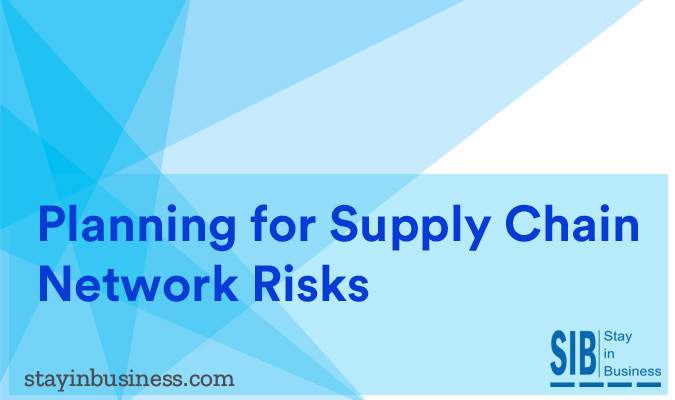
Planning for Supply Chain Network Risks
Evaluating Order Fulfillment
Better order fulfillment can be achieved through customer integration, internal integration and technology for integrating supply chain networks.
- Available to Promise
- Fill rate
- Percentage of perfect orders delivered
Customer Integration
- Establishing relationships that go beyond sales
- Staying prepared for specific customer needs
- Streamlining activities with clients
- Constantly exploring new avenues for business relationships
Internal Integration
- Creating awareness of roles & responsibilities across teams, departments and divisions
- Establishing a prioritization methodology for sorting all customers
- Establishing common roadmaps for all products
- Exchanging operational information
- Using performance metrics that balance cost and service ratios
Technology for Integrating Supply Chain Networks
- Managing long distance orders
- Event management
- Integrating enterprise applications
- Using RFID
Product Quality Improvement
Product quality can be improved through internal and supplier integration.
- Adhering to product requirements
- Designing products with an emphasis on performance, features and functionalities
- Product dependability and brand trustworthiness
Internal Integration
- Creating awareness of roles & responsibilities across teams, departments and divisions
- Establishing a prioritization methodology for sorting all customers
- Establishing common roadmaps for all products
- Exchanging operational information
- Using performance metrics that balance cost and service ratios
Supplier Integration
- Developing crucial supplier competencies by nurturing relationships
- Sharing information on operations
- Synchronizing processes that involve suppliers
- Continuously exploring new avenues for business relationships
Improving Asset Utilization
Assets can be better utilized by
- Segmenting supply chain networks
- Making plans more effective
- Implementing
- Supplier integration
- Technology for
- Integrating supply chain networks,
- Tactical and strategic planning
- Time period between paying suppliers and being paid by customers
- Average number of days for which goods are kept in inventory
- The ratio of total company income to total monetary value of all assets
- The precision with which future demands are predicted
Segmenting Supply Chain Networks
- Constantly updating strategies for categorizing customer profiles
- Categorizing products as per their profitability and lifecycle stage
Effective Planning
- Process driven approach that is adopted for both short term and long term activities
- Scenario based approach for contingency planning and risk assessments
- Using feedback loops to identify and resolve deviations
- Protecting operational vulnerabilities
- Developing plans for business continuity
Supplier Integration
- Developing crucial supplier competencies by nurturing relationships
- Sharing information on operations
- Synchronizing processes that involve suppliers
- Continuously exploring new avenues for business relationships
Technology for Integrating Supply Chain Networks
- Managing long distance orders
- Event management
- Integrating enterprise applications
- Using RFID
Technology for Tactical Planning
- Sales and operations planning
- Advanced planning systems
- Distribution planning
Technology for Strategic Planning
- Business Intelligence
- Intelligent Supply Chain Network Management
- Product lifecycle management
- Network optimization
Flexible Supply Chain Network Risk Management
Your organization’s approach to managing supply chain network risks can be made more flexible through strategic alignment, supplier integration, effective planning and technology for relationship management.
- Time period from receiving customer order to delivering finished products
- Supply chain network’s ability to respond to changes in market demand
- The extent to which the type and volume of production can be adapted
Strategic Alignment
- Using business strategy to propel supply chain network goals and objectives
- Designing business strategies to maximize supply chain network capabilities and minimize limitations
- Maintaining all staff members informed on business strategies
Supplier Integration
- Developing crucial supplier competencies by nurturing relationships
- Sharing information on operations
- Synchronizing processes that involve suppliers
- Continuously exploring new avenues for business relationships
Effective Planning
- Process driven approach that is adopted for both short term and long term activities
- Scenario based approach for contingency planning and risk assessments
- Using feedback loops to identify and resolve deviations
- Protecting operational vulnerabilities
- Developing plans for business continuity
Technology for Relationship Management
- Collaborative Planning, Forecasting and Replenishment
- Customer Relationship Management
- Supplier relationship management
- Supplier Performance
Improving Cost Performance
You can improve cost performance across your supply chain network through a combination of customer integration, internal integration, effective planning and technology for implementation systems.
- Supply chain network costs
- Cost of goods sold
- Cost of managing warranties and returns
Customer Integration
- Establishing relationships that go beyond sales
- Staying prepared for specific customer needs
- Streamlining activities with clients
- Constantly exploring new avenues for business relationships
Integral Integration
- Creating awareness of responsibilities across teams, departments and divisions
- Establishing a prioritization methodology for sorting all customers
- Establishing common roadmaps for all products
- Exchanging operational information
- Using performance metrics that balance cost and service ratios
Effective Planning
- Process driven approach that is adopted for both short term and long term activities
- Scenario based approach for contingency planning and risk assessments
- Using feedback loops to identify and resolve deviations
- Protecting operational vulnerabilities
- Developing plans for business continuity
Technology for Implementation Systems
- Warehouse management system
- Transportation management system
- Enterprise resource planning
- Electronic procurement
- JIT / Kanban
See for yourself how the application works
Witness our cloud based platform’s security capabilities in action
Play around with the software and explore its features
Compare and choose a solution that’s relevant to your organization
Consult our experts and decide on a pricing mechanism




